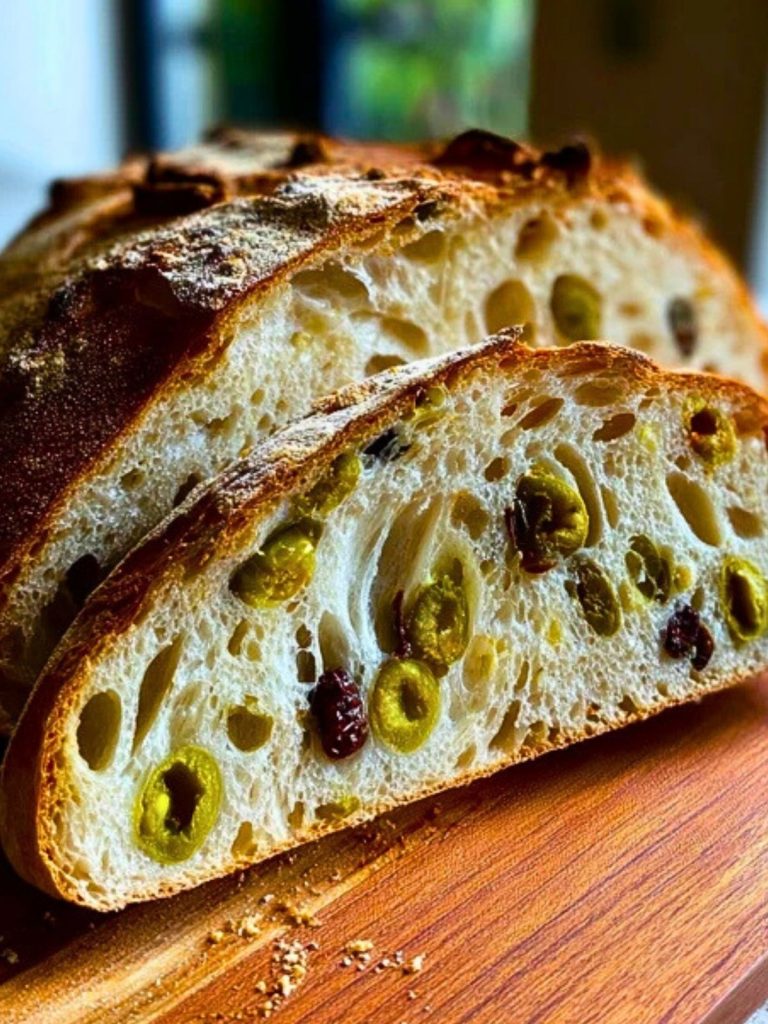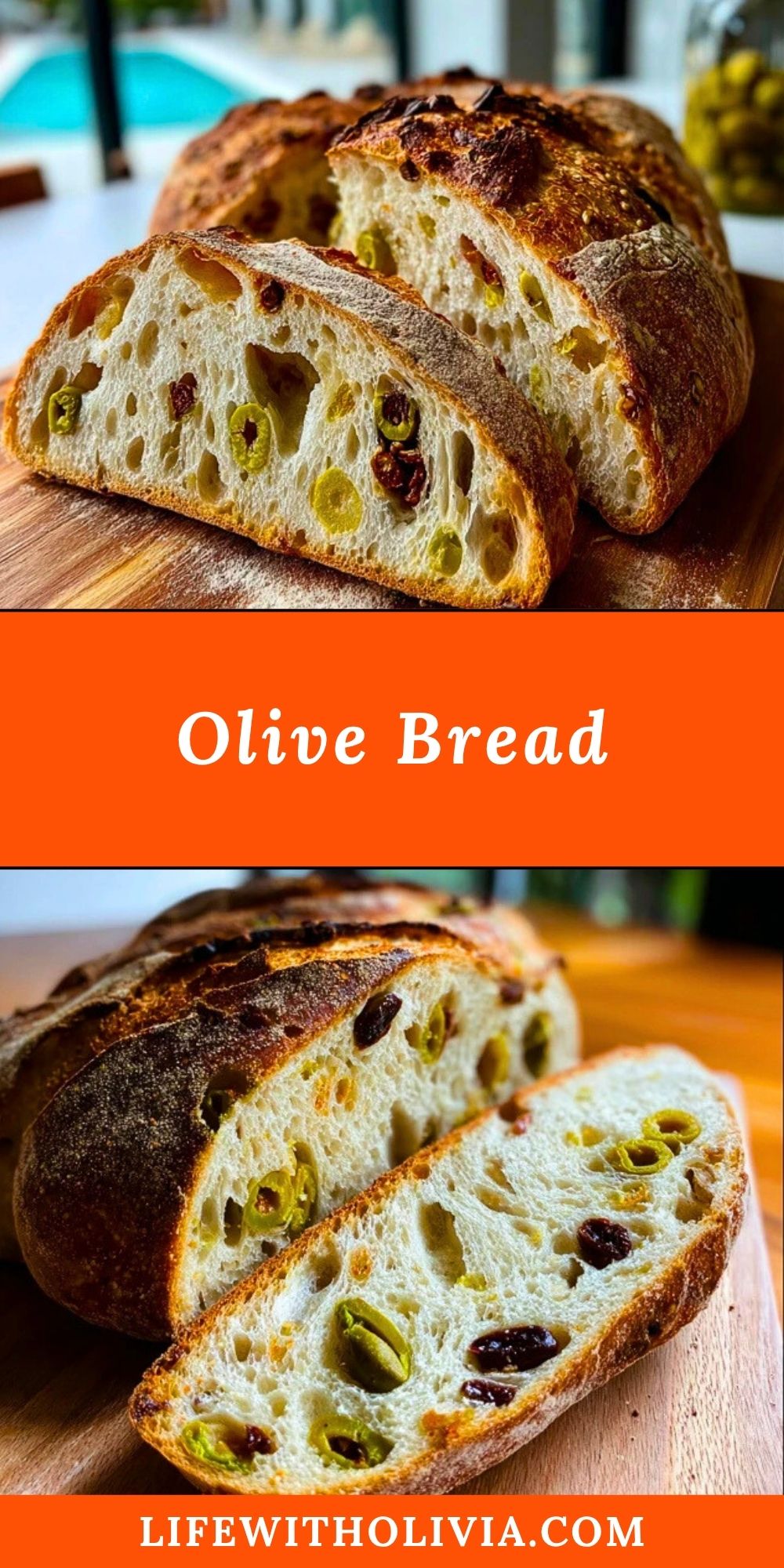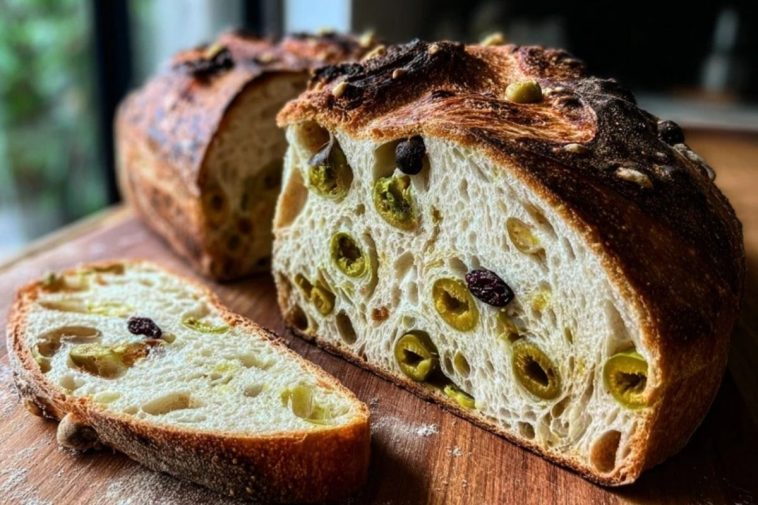With a crackly crust and a chewy interior packed with briny green and Kalamata olives, Olive Bread brings a touch of the Mediterranean to your kitchen. It’s the kind of rustic artisan loaf you’d expect to find at a European bakery, but with the right method, you can make it at home with no fuss.
What makes this bread stand out is its depth of flavor. The olives add saltiness and richness, while the slow fermentation process builds complexity in every bite. It pairs beautifully with soups, salads, or cheese boards, and is equally satisfying toasted with a drizzle of olive oil. Whether you’re a seasoned baker or just dipping your toes into bread-making, this is a rewarding project.
Preparation Phase & Tools to Use
Creating a well-baked olive bread starts with having the right tools. Here’s what you’ll need and why each matters:
- Mixing Bowls: Use large, non-reactive bowls for mixing and bulk fermentation. Stainless steel or glass is best.
- Digital Scale: Precise measurements are key to bread-making. A scale ensures accuracy, especially for flour and water ratios.
- Bench Scraper: Helps in shaping the dough and cleaning your workspace efficiently.
- Dutch Oven or Cast-Iron Pot: Crucial for baking artisan-style bread. The enclosed environment traps steam, leading to that golden, crisp crust.
- Proofing Basket or Bowl with Towel: Supports the dough during its final rise and helps retain its shape.
- Lame or Sharp Knife: To score the top of the dough before baking. This allows controlled expansion and adds that classic artisan look.
These tools don’t just make the process smoother—they help guarantee results that are crusty on the outside, airy on the inside, and flavorful throughout.


Ingredients for the Olive Bread
- Bread Flour: Provides strong gluten structure for that chewy, airy texture. Essential for holding up to the weight of olives.
- Water: Hydrates the flour, activates gluten, and aids in fermentation. Use filtered or spring water if possible.
- Active Dry Yeast: Gives the dough its rise. A small amount goes a long way in a slow fermentation.
- Salt: Enhances flavor and controls yeast activity. Don’t skip this!
- Green Olives: Briny and slightly tangy, they add bursts of flavor. Use pitted and roughly chopped.
- Kalamata Olives: Rich and dark, they balance the green olives with deeper umami tones. Also pitted and chopped.
- Olive Oil (Optional): A light drizzle enhances the Mediterranean aroma and softens the crumb slightly.
How To Make the Olive Bread
Step 1: Mix the Dough
In a large bowl, combine bread flour, water, salt, and yeast. Stir until no dry spots remain. The dough will be sticky and shaggy—that’s okay.
Step 2: First Rise (Bulk Fermentation)
Cover the bowl with a damp towel or plastic wrap and let it sit at room temperature for 10 to 12 hours. During this time, the dough will double in size and form bubbles.
Step 3: Add the Olives
Lightly flour your surface. Turn out the dough and stretch it gently into a rectangle. Sprinkle the chopped olives evenly over the surface. Fold the dough over itself a few times to incorporate.
Step 4: Shape and Second Rise
Shape the dough into a round or oval loaf. Place it seam-side up in a floured proofing basket or bowl lined with a towel. Let rise for 45 to 60 minutes.
Step 5: Preheat and Score
Preheat your oven to 475°F (245°C) with the Dutch oven inside. When the dough is ready, carefully transfer it to parchment paper. Score the top with a sharp blade.
Step 6: Bake
Transfer the dough into the hot Dutch oven. Bake covered for 20 minutes, then uncovered for another 20-25 minutes until the crust is deep golden brown.
Step 7: Cool
Let the bread cool on a wire rack for at least 1 hour before slicing. This helps set the crumb and enhances flavor.
How to Serve and Store Olive Bread
Freshly baked Olive Bread is best enjoyed slightly warm, sliced thick with a drizzle of extra virgin olive oil. It makes an exceptional partner for Mediterranean platters, hearty soups, or even just a slab of creamy butter. Toasted slices elevate simple toppings like hummus, feta, or roasted vegetables.
For storage, wrap the cooled loaf in a clean kitchen towel and keep it at room temperature for up to 2 days. For longer storage, slice and freeze the bread. Toast slices straight from the freezer for a quick, flavorful bite.
Frequently Asked Questions
What kind of olives work best for this bread?
A combination of green olives and Kalamata olives offers the best flavor balance. Green olives bring brightness, while Kalamatas offer depth.
Can I make this without a Dutch oven?
Yes, though the crust may differ slightly. Use a heavy baking sheet or pizza stone and add a tray of hot water at the bottom of your oven to create steam.
How long does Olive Bread last?
At room temperature, it stays fresh for 1–2 days. For longer keeping, freeze it. Avoid refrigeration, which can dry it out.
Can I add herbs like rosemary or thyme?
Absolutely. A teaspoon of finely chopped herbs can complement the olives beautifully. Add them with the olives during folding.
Is this recipe good for beginners?
Yes! It uses a no-knead, slow-rise method, which is very forgiving and ideal for home bakers just starting out.
Why is my dough so sticky?
Olive Bread dough has high hydration, which means it will be sticky. Don’t add too much flour—use a wet hand or bench scraper to handle it.
Want More Bread Ideas with a Savory Twist?
If you’re loving the rich, rustic flavors in this Olive Bread, check out these other delicious creations from the site:
• Soft and Fluffy Homemade Naan Bread for pillowy goodness perfect with curries or dips.
• Cinnamon Donut Bread if you’re craving a sweet and cozy loaf.
• Cheesy Garlic Chicken and Broccoli Pasta to pair with a slice of fresh olive bread.
• Million Dollar Ravioli Casserole as the ultimate comfort dinner with artisan bread on the side.
• Scalloped Corn Casserole that would love a rustic slice on its plate.
Save This Recipe for Later
📌 Save this recipe to your Pinterest board so you can make it again and again: Life With Olivia on Pinterest.
Tried this Olive Bread? Let me know how yours turned out in the comments! Did you go heavy on the olives or sneak in some garlic? Maybe added herbs?
Your baking stories help others, so share what worked for you (or what you’d tweak next time). I’d love to hear!


Olive Bread
- Total Time: 13 hours
- Yield: 1 large loaf
- Diet: Vegetarian
Description
This rustic Olive Bread boasts a chewy crumb, crackly crust, and deep Mediterranean flavor from green and Kalamata olives. It’s made with a slow-rise, no-knead dough and baked in a Dutch oven for an artisan-quality loaf at home. Perfect for dipping, toasting, or enjoying plain and warm.
Ingredients
3 ½ cups bread flour
1 ½ cups water
½ teaspoon active dry yeast
2 teaspoons salt
1 cup green olives, pitted and chopped
½ cup Kalamata olives, pitted and chopped
1 tablespoon olive oil (optional)
Instructions
1. In a large bowl, mix bread flour, water, yeast, and salt until a sticky, shaggy dough forms.
2. Cover with plastic wrap or a damp towel and let rise at room temperature for 10–12 hours.
3. Flour your surface lightly, stretch dough into a rectangle, and add the chopped olives. Fold several times to incorporate.
4. Shape dough into a round or oval loaf. Place seam-side up into a floured proofing basket or towel-lined bowl. Let rest for 45–60 minutes.
5. Preheat oven to 475°F (245°C) with a Dutch oven inside.
6. Place dough on parchment paper, score the top, and carefully transfer it into the hot Dutch oven.
7. Bake covered for 20 minutes, then uncovered for another 20–25 minutes until the crust is deep golden.
8. Remove bread and let cool on a wire rack for at least 1 hour before slicing.
Notes
Don’t add too much flour when shaping—sticky dough is key to a light crumb.
The olives can be patted dry before adding to avoid excess moisture.
For added depth, mix in fresh rosemary or thyme during the folding stage.
- Prep Time: 15 minutes
- Cook Time: 45 minutes
- Category: Bread
- Method: Baking
- Cuisine: Mediterranean
Nutrition
- Serving Size: 1 slice
- Calories: 170
- Sugar: 0g
- Sodium: 340mg
- Fat: 3g
- Saturated Fat: 0.5g
- Unsaturated Fat: 2g
- Trans Fat: 0g
- Carbohydrates: 30g
- Fiber: 1g
- Protein: 5g
- Cholesterol: 0mg
Keywords: olive bread, no knead, artisan bread



